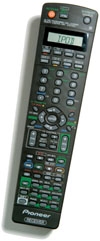Pioneer VSX-74TXVi Digital Surround Receiver Page 2
MUSIC PERFORMANCE Beginning with stereo CD playback, the Pioneer proved wholly satisfying. Clean, hyper-detailed productions like Steely Dan's classic Gaucho delivered all the clarity and tonal precision I expected on Donald Fagen's distinctive nasal whine, plus all the dynamic detail I expected. And the Pioneer produced plenty of power when I cranked things up, like when I played the DVD-Audio version of Steely Dan's Everything Must Go. The golden-years funk of "Pixeleen" easily got my furniture a-vibrating without distortion or audible strain.
Turning my attention to satellite radio, XM sounded great through my reference speakers. I can't say that critical listeners won't ever hear artifacts of XM's compression, which is similar to MP3. I heard the occasional tinge of "swirly" background noise on a very quiet passage. But in general, sound was impressively clean and musical. Handel's Water Music, heard on XM's serious classical channel (110), was quiet, transparent, and crisply detailed.
Sound from the iPod was just that - iPod sound. Since the dock connection sends the 'Pod's own analog stereo signal to the receiver's input, quality varies based on the track. As with any compressed music, you'll hear glitches on tracks encoded at low bit rates, but if you stick with Apple's AAC encoding at 320 kilobits per second, you'd be hard pressed to tell the difference in direct comparisons with a CD. To spice things up, you can also dial in any applicable surround processing mode that turns stereo into multichannel sound.
MOVIE PERFORMANCE The "Reconstruction" DVD release of Samuel Fuller's flawed but fascinating WW II epic, The Big Red One, has several scenes with explosions that drive four, five, and even six channels to peak levels simultaneously. The Pioneer never once stumbled or showed any sign of audible distortion. Sound on Dolby Digital and DTS material was unfailingly clean, detailed, and dynamic.

EASE OF USE The Pioneer's densely populated universal remote assigns many critical functions a dedicated key - a good thing. But with so many keys, the layout is cramped - not so good. The omission of backlighting or even glow-in-the-dark labels is surprising for a $1,700 receiver, and the use of dim red and green lettering makes for a lot of squinting. (On the other hand, Pioneer's simple onscreen menus were amply clear and helpful.) If you use the remote to control other components, you'll be doing a lot of switching back and forth between its receiver-controlling mode and the external-component modes. I learned to use it, but I couldn't learn to love it.
Selecting channels on XM is the same as tuning an AM or FM station: scroll up/down, choose a preset, or enter a channel by number. The receiver's XM display includes only basic artist/title info - but that's a result of the XM datastream.
Playback from an iPod was equally simple. Selecting the labeled iPod input brings up an onscreen menu for selecting Artists, Albums, Playlists, and so on using the remote's four-way cursor keypad. The remote's iPod transport controls work as expected, and the receiver's onscreen display includes full artist, title, time, and track-number data for the song that's playing and even a nice version of the iPod progress bar. Loading menus and skipping tracks takes a second or two longer than when using the iPod directly, but overall I found the Pioneer's integration intuitive, effective, and a pleasure to use.
BOTTOM LINE The Pioneer VSX-74TXVi is a very fine performer whose key qualities hold their own against other, more expensive "flagship" A/V receivers, including Pioneer's own. On the other hand, there are less expensive models that can match it, or nearly so, in all the important basics (including, again, some from Pioneer). Fortunately, what it has to offer beyond the basics are extras of obvious and potent value. If you're intrigued by a receiver with XM radio and iPod-ability, extensive input/output flexibility, and some pretty elaborate auto-setup and EQ functions, and aren't put off by its substantial sticker, then this is a receiver you'll want to check out.













































